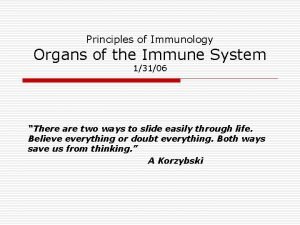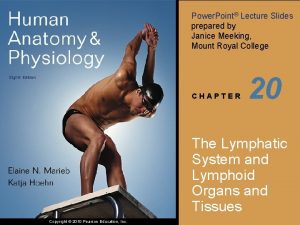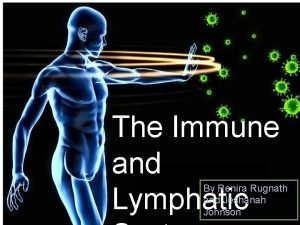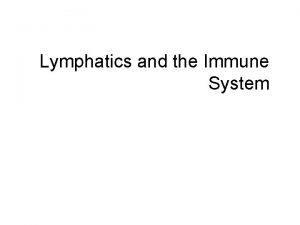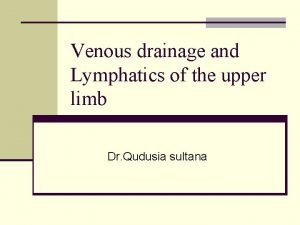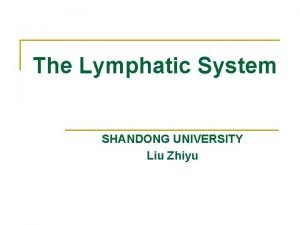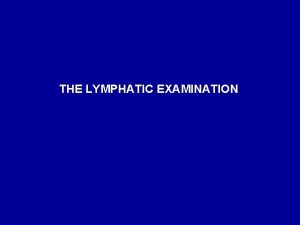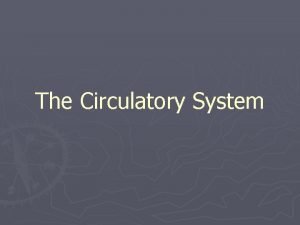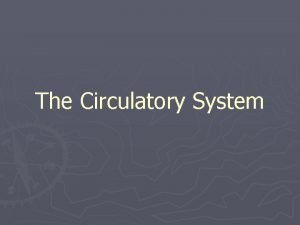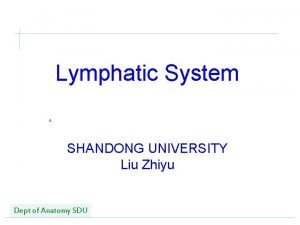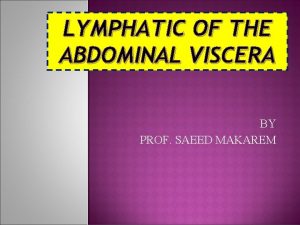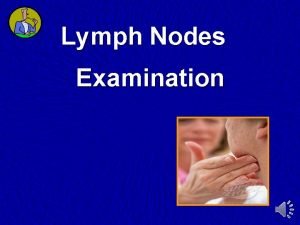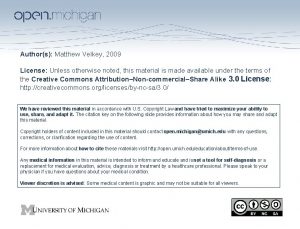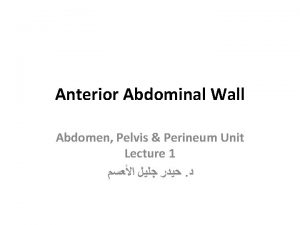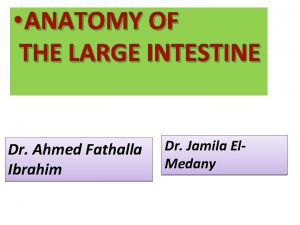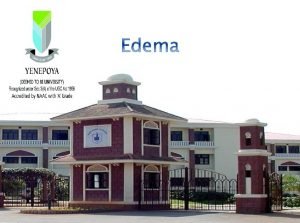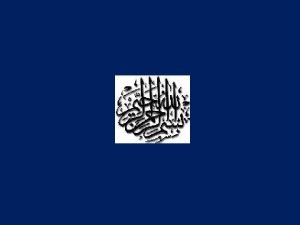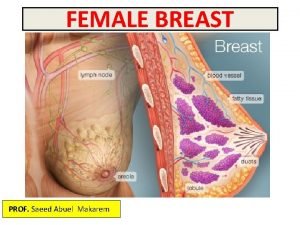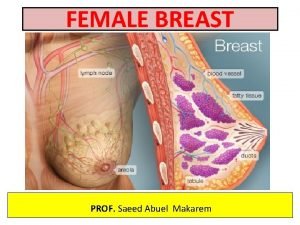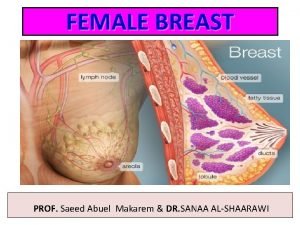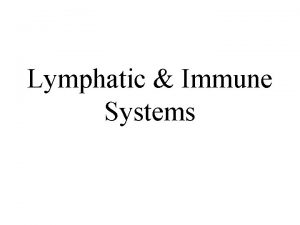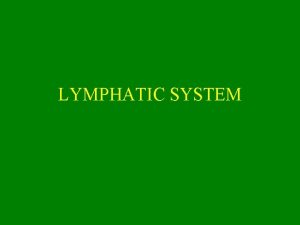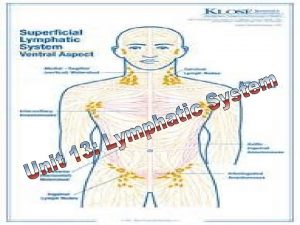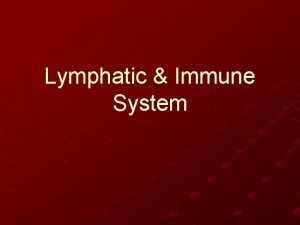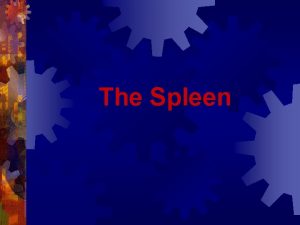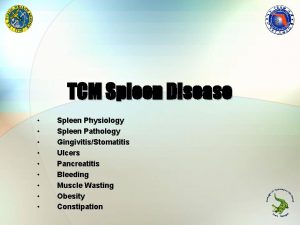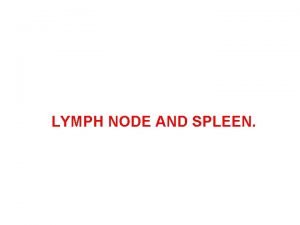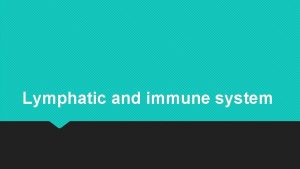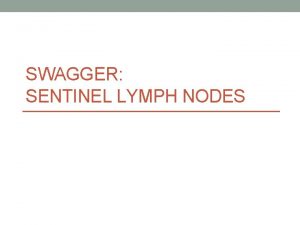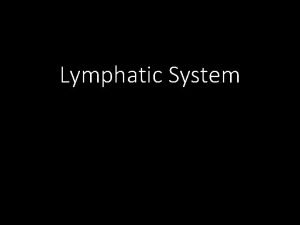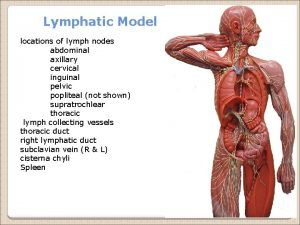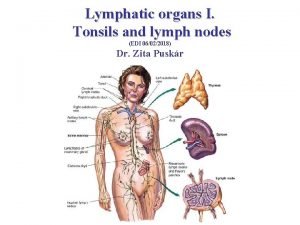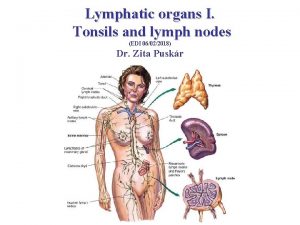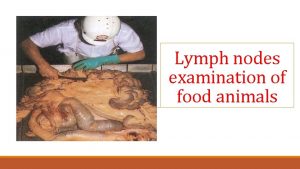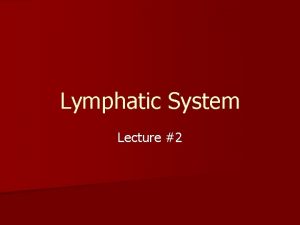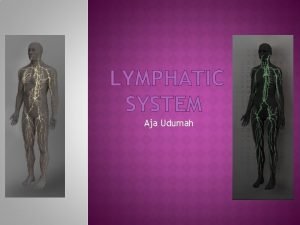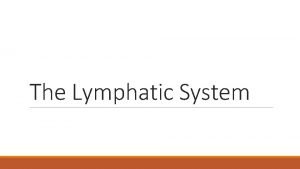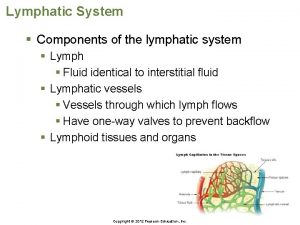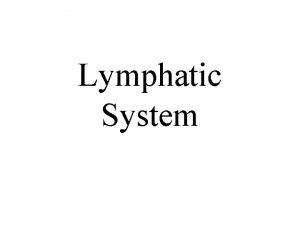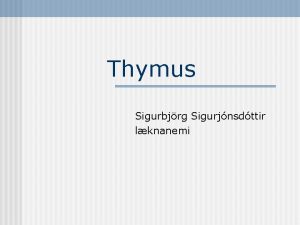The Lymphatic Immune Systems Thymus Spleen Lymph nodes






























- Slides: 30

The Lymphatic & Immune Systems Thymus Spleen Lymph nodes Lymphatic vessel 1

Objectives After studying this chapter, you will be able to: • Name the parts of the lymphatic and immune systems and discuss the function of each part • Define combining forms used in building words that relate to the lymphatic and immune system • Identify the meaning of related abbreviations • Name the common diagnoses, clinical procedures, and laboratory tests used in treating the lymphatic and immune systems 2

Objectives Part 2 • List and define the major pathological conditions of the lymphatic and immune systems • List common pharmacological agents used in treating disorders of the lymphatic and immune systems. 3

Lymphatic Organs and Structures The Lymphatic and Immune System Lymphatic Organs and Structures Lymph • A fluid containing: -water -salts -sugars -waste -white blood cells -protein Lymph Vessels • Carry lymph within the lymphatic system • Lymph capillaries are the smallest of the lymph vessels 4

Capillaries have thin walls which allow fluid in body tissues to flow between the capillaries and tissues. Fluid in the spaces between tissues is called interstitial fluid Once the interstitial fluid flows into the lymph capillaries it is called lymph Lymphatic trunk Right lymphatic duct or thoracic duct Lymphatic vessel Lymphatic capillary Right subclavian vein (neck) Interstitial fluid Blood stream 5

Lymphatic Vessels Lymphatic capillaries Pulmonary capillary network Lymph node Lymphatic vessels Lymph flow Blood flow Lymph node Lymph flow Systemic capillary network Lymphatic capillaries 6

Lymph Nodes • Specialized organs that produce lymphocytes • Filter harmful substances from the tissues • Contain macrophages that devour foreign substances • Lymphocytes produce specialized proteins called antibodies that fight disease • Antigens also fight disease by stimulating an immune response in other cells 7

Lymph • Travels in only one direction • Empties into the right thoracic duct and the lymphatic duct • Lipids are transported from the small intestines to the blood stream by the lymph vessels Location of major groups of lymph nodes: -tonsils -adenoids -groin -neck -mediastinum -armpit 8

Organs of the System Organs of. Lymphatic the Lymphatic Spleen -largest lymphatic organ -located in upper left portion of the abdominal cavity -filters foreign material from the blood -destroys old red blood cells -activates lymphocytes Thymus Gland -soft gland with two lobes -larger during infancy and childhood -contains important cells called thymocytes (ex. T cells) -T cells (T lymphocytes provide immunity) -thymosin aids with T cell movement 9

Immune System Consists of a series of defenses against intruders, such as microorganisms Mechanical Defenses Chemical Defenses • skin • nasal cilia • mucous membranes • stomach gastric juices Other Barriers Phagocytosis The ingesting of foreign substances by specialized cells like macrophages 10

Types of Immunity Acquired Passive Natural Immunity A natural resistance to certain diseases in which the extent varies from person to person Immunity Types of Immunity provided in the form of antibodies or antitoxins that have been developed in another person or species Acquired Active Immunity that develops after having the disease or after being vaccinated against the disease 11

Major Immunoglobulins Immunogobulin G (Ig. G) -effective against bacteria, viruses and toxins Immunoglobulin A (Ig. A) -common in exocrine gland secretions such as breast milk and tears Immunoglobulin M (Ig. M) -first antigen to be produced after an infection Immunoglobulin D (Ig. D) -important in B-cell activation Immunoglobulin E (Ig. E) -appears in glandular secretions and is associated with allergic reactions NOTE: This type of immunity is provided by plasma cells and is called humoral immunity. 12

Cell-mediated Immunity This type of immunity is provided by the action of the T-cells which multiply rapidly and produce certain proteins in response to antigens. Three Types of Specialized T-Cells • Helper cells or CD 4 cells that stimulate the immune response • Cytotoxic cells or CD 8 cells that help in the destruction of infected cells • Suppressor cells or T cells that suppress B-cells and other immune cells 13

Combining Forms & Combining Form Meaning Abbreviations (aden) gland aden (o) immunity lymph (o) lymphaden (o) lymph nodes lymphangi (o) lymphatic vessels splen (o) spleen thym (o) thymus tox (o) poison 14

Combining Forms & Abbreviation Meaning Abbreviations (AIDS) AIDS acquired immunodeficiency syndrome ALL acute lymphocytic leukemia AML acute myelogenous leukemia AZT azidothymidine CLL chronic lymphocytic leukemia 15

Combining Forms & Abbreviation Meaning Abbreviations (CML) chronic myelogenous leukemia CML CMV cytomegalovirus EBV Epstein-Barr virus ELISA enzyme-linked immunosorbent assay HIV human immunodeficiency virus HSV herpes simplex virus Ig. A immunoglobulin A 16

Combining Forms & Abbreviation Meaning Abbreviations (Ig. D) immunoglobulin D Ig. E immunoglobulin E Ig. G immunoglobulin G Ig. M immunoglobulin M PCP pneumocystis carinii pneumonia SLE systemic lupus erythematosus ZDV zidovudine 17

Diagnostic, Procedural & Laboratory Terms CAT Scans are used frequently to diagnose abnormalities of the lymph organs Blood tests that indicate the number and condition of the white blood cells are used in diagnosing lymph and immune system diseases 18

Pathological Terms Diseases of the lymph and immune system that flourish are those diseases which suppress the immune response. Acquired immunodeficiency syndrome (AIDS) is the most widespread immunosuppresive disease. Opportunistic Malignancies and Infections Associated with AIDS • candidiasis • cytomegalovirus • Kaposi’s sarcoma • Mycobacterium aviumintracellulare (MAI) • Pneumocystis carinii 19 pneumonia

How is HIV Transmitted? Contaminated needles Sexual contact How is HIV Transmitted? During birth if the mother is infected Receiving infected blood or other tissue 20

How is HIV Not Transmitted? mosquitoes Swimming in the same water as infected persons Objects like toilet seats, doorknobs etc. How is HIV NOT Transmitted? Casual contact like hugging and kissing Sharing food 21

Pathological Terms Lymphoma Non-Hodgkin’s Lymphoma • A type of lymph cancer that appears in early adulthood and the cause or origin is uncertain • Involves the lymph nodes and spleen NOTE: • A type of cancer of the lymph nodes in which some of the cells resemble healthy cells • Usually appears during mid-life • Malignant cells resemble large lymphocytes Depending on how far the disease has spread, both types can be arrested with chemotherapy 22 and radiation.

Non-malignant Diseases Sarcoidosis • Inflammatory condition that can affect lung functioning Infectious Mononucleosis • Also called the kissing disease • An acute infectious disease caused by the Epstein-Barr virus • Swollen lymph nodes are a common symptom 23

Allergy Facts Allergies are a problem of the immune system that affect millions of people Allergy Facts • Allergies are due to the production of the Ig. E antibodies against an allergen • Hypersensitivity increases as exposure increases • Anaphylaxis may occur which is life-threatening if the allergy is 24 severe

Autoimmune Diseases • Conditions in which the body’s immune system turns against its own healthy tissue • An autoimmune response is the result of the T cells attacking their own healthy cells Examples lupus rheumatoid arthritis scleroderma 25

Surgical Terms Cancer of the lymph system may require a lymph-node dissection. Other Procedures • lymphadenectomy -removal of a lymph node • lymphadenotomy -incision into a lymph node • splenectomy -removal of the spleen • thymectomy -removal of the thymus gland 26

Pharmacological Terms Diseases of the lymph and immune systems often require high doses of chemotherapy and/or radiation for treatment. Other Medications antivirals antimicrorganism agent antihistamines used to treat AIDS by blocking viral growth used to prevent PCP in AIDS patients used to prevent or lessen allergic 27 reactions

Apply Your knowledge Which of the following statements explains a major difference between lymph and blood? A. Lymph contains white blood cells and platelets. B. Lymph contains only white blood cells. C. Lymph contains only red blood cells and white blood cells. Answer: B. Lymph contains only white blood cells. 28

Apply Your Knowledge Part 2 Sharon, age 5 is taken to the doctors for her complaint of a sore throat. Her pediatrician might find which of the following signs during his assessment of the lymphatic system? A. elevated temperature B. increased blood pressure C. swollen lymph nodes Answer: C. swollen lymph nodes 29

Apply Your Knowledge Part 3 Andy has recently been diagnosed with HIV. He is concerned that some of his friends might catch the virus from him. Place the following examples in the correct box based on their ability to transmit HIV. needle stick sexual contact Will Transmit HIV mosquitoes kissing toilet seats Will NOT Transmit HIV Examples: kissing, accidental needle stick, mosquitoes, toilet seats, sexual contact 30
 Immune system lymph nodes
Immune system lymph nodes Lymph tends to stall inside lymph nodes. this is due to:
Lymph tends to stall inside lymph nodes. this is due to: Lymph tends to stall inside lymph nodes
Lymph tends to stall inside lymph nodes Thymus
Thymus Chapter 24 the immune and lymphatic systems and cancer
Chapter 24 the immune and lymphatic systems and cancer Chapter 24 the immune and lymphatic systems and cancer
Chapter 24 the immune and lymphatic systems and cancer A subsequent
A subsequent Lymphatic vs immune system
Lymphatic vs immune system Lymphatic vs immune system
Lymphatic vs immune system Venous drainage of the upper limb
Venous drainage of the upper limb Veins in cubital fossa
Veins in cubital fossa Lymph nodes lower body
Lymph nodes lower body Left lymphatic duct
Left lymphatic duct Lymphatic drainage
Lymphatic drainage Lymph nodes in forearm
Lymph nodes in forearm Lymph nodes: “filters of the blood”
Lymph nodes: “filters of the blood” Lymph nodes: “filters of the blood”
Lymph nodes: “filters of the blood” Posterior axillary
Posterior axillary Lymphatic drainage abdomen
Lymphatic drainage abdomen Cisterna chyli
Cisterna chyli Supraclavicular lymph nodes swollen
Supraclavicular lymph nodes swollen Lymph nodes function
Lymph nodes function Rectus abdomen muscle
Rectus abdomen muscle Cecum intraperitoneal or retroperitoneal
Cecum intraperitoneal or retroperitoneal Grading pitting edema
Grading pitting edema Gluteal ligaments
Gluteal ligaments Ophthalmic artery
Ophthalmic artery Nerve supply of female breast
Nerve supply of female breast 5 groups of axillary lymph nodes
5 groups of axillary lymph nodes 5 groups of axillary lymph nodes
5 groups of axillary lymph nodes Jugular chain
Jugular chain
